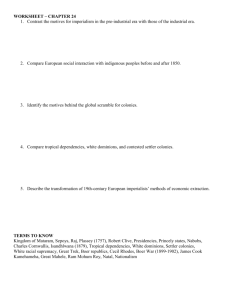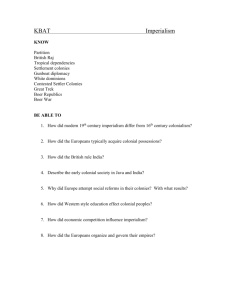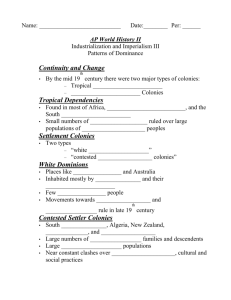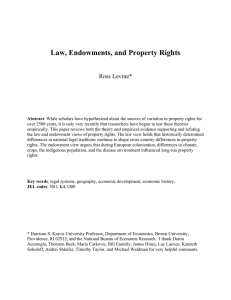The roles of institutions
advertisement
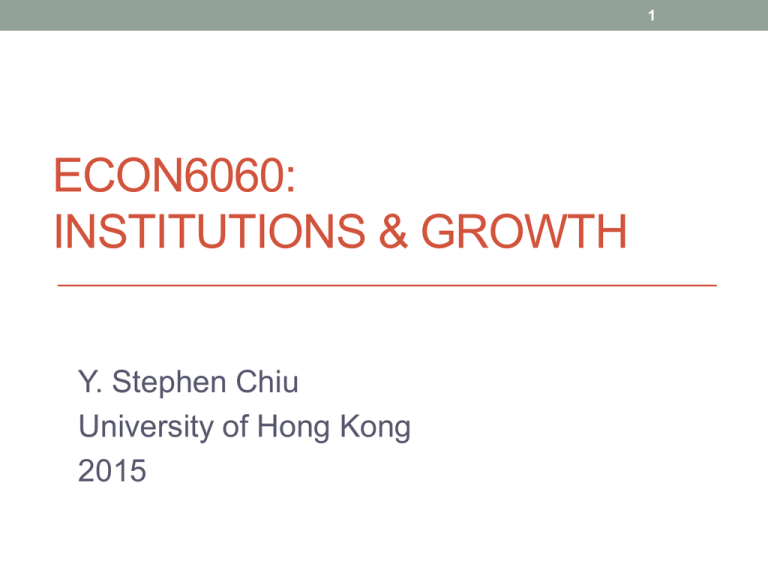
1 ECON6060: INSTITUTIONS & GROWTH Y. Stephen Chiu University of Hong Kong 2015 2 Alibaba IPO • Two years ago, the Alibaba Group asked to have its IPO in HK under a partnership structure • a majority of board members will be proposed by the founders/ management term/etc. • Shareholders rights are restricted 3 Are HK regulators/people too rigid? • Alibaba is now listed in New York after failing in HK • HK is commended for upholding its principles of protecting shareholders’ rights • HK is also criticized for lacking flexibility, unable to adapted to changes • Law, regulations, etc. are institutions that are widely thought to be important for economic development • But institutions are also adaptive to economic development. So are institutions really important? 4 A methodological problem • Suppose we regress economic growth on institution and find a positive relationship. We cannot conclude that it is institutions that cause economic growth, because it may be the reverse that is true. • Solution: Instrumental variable (IV), find a variable that is closely related with institution, but unrelated to economic growth other than this channel 5 Acemoglu, Johnson, Robinson (AER 2001) • Acemoglu, Johnson, & Robinson (AER, 2001): • “The Colonial Origins of Comparative Development: An Empirical Investigation” • examines former colonies • Institution: property rights protection 6 Model • And α is found to be positive and significant! 7 8 Playing devil’s advocate • Three problems of endogeneity: • Richer countries can afford better institutions • Omitted variables • Bias in dataset: perceiving better institutions in richer countries 9 Instrumental variable • Correlation between institution quality and income need not imply causality=> use IV • Strategy: Instrument institution by settler mortality rates 10 Acemoglu, Johnson, Robinson (AER 2001) • Main findings: institutions matter, e.g., improving Nigeria’s institutions to the level of Chile could, in the long run, lead to as much as a 7-fold increase in Nigeria’s income (in practice Chile is over 11 times as rich as Nigeria). 11 A first look Colonies where Europeans faced higher mortality rates are today substantially poorer than colonies that were healthy for Europeans. 12 SMR & choice of settlement policy • “An interesting example of the awareness of the disease environment comes from the pilgrim fathers. They decided to migrate to the US rather than Guyana because of the high mortality rates in Guyana. • “Another example comes from the Beauchamp committee in 1795, set up to decide where to send British convicts who had previously been sent to the US. One of the leading proposals was the Island of Lemane, up the Gambia River. The committee rejected this possibility because they decided mortality rates would be too high even for the convicts. Southwest Africa was also rejected for health reasons. The final decision was to send convicts to Australia.” (AJR, p1374) • So a difference in settler mortality rate was well aware of 13 A successful empirical work provides that • The exclusion principle holds that: SMRs have no effect on GDP per capita today, other than their effect through institutional development. 14 Exclusion restriction • Concern: SMRs could be correlated with the current disease environment, which may have a direct effect on economic performance. Then the IV estimates may be assigning the effect of diseases on income to institutions. • Unlikely a problem… • The great majority of European deaths in the colonies were caused by malaria and yellow fever. Although these diseases were fatal to Europeans who had no immunity, they had limited effect on indigenous adults who had developed various types of immunities. These diseases are therefore unlikely to be the reason why many countries in Africa and Asia are very poor today. 15 Exclusion restriction • Disease was not a concern for indigenous people • Annual mortality rates (AMR) of local troops (indigenous people) serving with the British army in Bengal and Madras: 11 & 13 to 1,000 • AMR of British troops serving in Britain:15 in 1,000 • But AMR of British troops serving in Bengal and Madras: between 70 to 170 in 1,000. 16 Types of colonization and settlements • “Historians have documented the development of settler colonies, where Europeans settled in large numbers, and life was modeled after the home country. • “Denoon (1983) emphasizes that settler colonies had representative institutions which promoted what the settlers wanted and that what they wanted was freedom and the ability to get rich by engaging in trade. 17 How European institutions were developed in colonies • “from the late 1840s the British bowed to local pressures and, in line with observed constitutional changes taking place in Britain herself, accepted the idea that, in mature colonies, governors should in future form ministries from the majority elements in elected legislatures. • ‘the enormous boom in public investment after 1870 [in New Zealand]…was an attempt to build up an infrastructure…to maintain high living standards in a country where voters expected politicians actively to promote their economic welfare.” 18 Non-settler colonies • “This is in sharp contrast to the colonial experience in Latin America during the 17th and 18th centuries, and in Asia and Africa during the 19th and 20th centuries. The main objective of the Spanish and Portuguese colonization was to obtain gold and other valuables from America. Soon after the conquest, the Spanish crown granted rights to land and labor (the encomienda) and set up a complex mercantilist system of monopolies and trade regulations to extract resources from the colonies. • “European developed the slave trade in Africa for similar reasons. 19 Extractive institutions • Probably the most extreme case of extraction was that of King Leopold of Belgium in the Congo: • Leopold’s philosophy was that “the colonial should be exploited, not by the operation of a market economy, but by state intervention and compulsory cultivation of cash crops to be sold to and distributed by the state at controlled prices.” • See wiki on Congo: http://en.wikipedia.org/wiki/Democratic_Republic_ of_the_Congo 20 Persistence of institutions • Fact: “although we commonly described the independent polities as ‘new states,’ in reality they were successors to the colonial regime, inheriting its structures, its quotidian routines and practices, and its more hidden normative theories of governance” (Crawford Young, 1994) • (Think of Hong Kong: government is still run by the civil servant system inherited from the British rule) 21 Main variables • Current performance y: Income per capita in 1995 • Current institution R: 0-10, Average protection against • • • • • • expropriation risk, average of 1985-1995 (from Political Risk Services http://www.prsgroup.com/ ) Early institution C: Constraint on executive in 1900 Early institution C: Democracy in 1900 Early institution C: Constraint on executive in 1st year of independence Settlement S: European settlements in 1900 (fraction of population with European descent) European settler mortality: death per 1000 in a year (from Curtin’s works) Geography Latitude: 0-1, away from earth equator 22 What institutions to study? • Footnote 3: Government expropriation is not the only institutional feature that matters. Our view is that there is a “cluster of institutions,” including constraints on government expropriation, independent judiciary, property rights enforcement, and institutions providing equal access to education and ensuring civil liberties, that are important to encourage investment and growth. Expropriation risk is related to all these institutional features. In Acemoglu et al. (2000), we reported similar results with other institutions variables. 23 other variables • British colonial dummy • French colonial dummy • French legal origin dummy 24 25 26 Determinants of current institutions (4) These regressions are to check if the schematic relationship makes sense The estimates are not significant as shown in Table 3 (3) (1) (2) 27 28 Choice of Instrument • Could we use settlement (S) or early institutions as the IV? • Why? Or why not? 29 Institutions and economic performance • Now the main analysis • 2-staged least-squares estimates 30 First stage least square regression 31 32 Dicussions • The magnitude of the 2SLS estimate • 2SLS estimate: 0.94 • Compare Nigeria and Chile • Difference in expropriation risk between them: 2.24 • Hence, 206 log point (appro 7-fold) difference in income • Latitude variable now has the “wrong” sign and insignificant • => many previous studies may have found latitude to be a significant determinant of economic performance because it is correlated with institutions 33 Competing theories • Legal origin: Hayek (1960) argued that the British common law tradition was superior to the French civil law, which was developed during the Napolenic ear to restrain judges’ interference with state policies. • Identity of colonizers: Landes (1998) and North (1998) argue that former British colonies prospered relative to former French, Spanish, and Portuguese colonies because of the good economic and political institutions and culture they inherited from British. • Geography: Diamond (1997): Guns, Gems, and Steel 34 35 Robustness: • settler mortality may be correlated with climate and other geographic characteristics 36 37 Robustness: • Settler mortality could be capturing the general effect of disease on development 38 39 Conclusion • Economics: evidence is found that institutions indeed affect economic performance • Empirical technique: the use of IV method; exclusion restriction • Questions: do you buy the paper? • The quantitative effect of current institutions on current income 40 Thank you!


